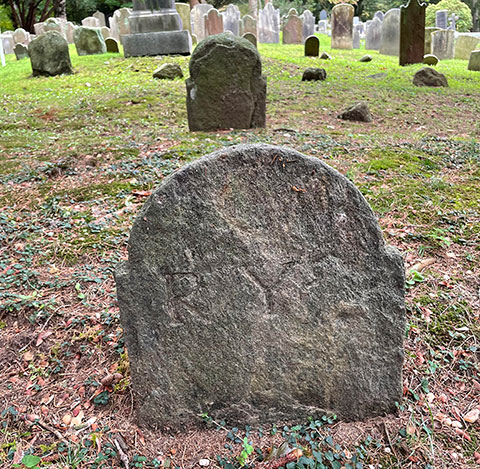Slavery in Oyster Bay: The Stories of 17 Souls
Slavery was legal in New York State for 201 years, beginning in 1626 and ending on July 4th, 1827, long after American independence promised that “all men are created equal” and were entitled to “life, liberty, and the pursuit of happiness.” New York was the epicenter of slavery in the North and, in 1770, had more slavery than any colony north of Maryland, and more than all the New England colonies combined. Long Island had the largest proportion within the colony, accounting for 40% of those enslaved in New York State.
Natural fieldstones in Youngs Cemetery, surrounded by white wooden crosses added later, mark the graves of people enslaved by the Youngs family.
Almost all of the crude stones are unmarked, though several bear a single letter to denote the first name of an enslaved person, followed by “Y’s,” for the name Youngs. This possessive language was literal, and typical in records to identify an enslaved person who had no last name. While no burial records have been found to correspond with these stone markers, seventeen names of individuals enslaved by members of the Youngs family of Oyster Bay have been uncovered through historical research. These names are:
Betty (or Bett), Charity, Charles Youngs, Dinah, Hannah, Harriot, James (or Jim), Jeff, Jem, Jenny, Margaret, Mary, Pline, Sue, Tamer, Tom, and Willis.

Three additional records identify people enslaved by the Youngs, but no name is given, only the following descriptors: “Daniel Youngs’…Wench”, “James Youngs’ Negro”, and Thomas Youngs’ “Black.”
These twenty records span several generations, from 1751 to 1822. Additional people may have been enslaved by the Youngs family without having their names written down, or their records may have been lost to time.
For More on the Youngs Family »
While the grave markers and white crosses reveal little about the identity of those buried beneath, we do know some details beyond the names of those who were enslaved, which serve as precious fragments of days that were full of hard labor and servitude. Beyond enslavement, each of these lives doubtlessly included moments of joy, the love of family, and the accomplishment of skilled work that helped to build our community, although the wealth derived from their work enriched the Youngs.
Records from the Town of Oyster Bay, Raynham Hall Museum, the East Hampton Library, and the New York Historical Society offer these brief glimpses:
Samuel Youngs’ 1751 will revealed that he owned only “one third part of My Negro Boy called Willis” which he passed down to his son Thomas Youngs, “to Have and to hold.” Estates that split ownership of slaves among multiple heirs created complex barriers to freedom.
Betty and Dinah were baptized in 1758 in the church that Daniel Youngs belonged to, called the “New Lights” congregation. Betty later bought several things from local merchant Samuel Townsend’s store, including a spelling book. It is possible that she learned how to read and write using this book.
Willis, Jem, and James were taken by Thomas Youngs to the local blacksmith in the mid-1760s for “bleeding”, or bloodletting, which was considered a medical treatment to improve health.
In the 1770s, Willis and Tom purchased small items, called “sundrys,” from Samuel Townsend. Willis also purchased rum and several yards of linen cloth, paying with potatoes. James bought similar items and paid with bushels of cucumbers. When Jeff bought rum and Sue purchased sugar, the cash that was paid may have been theirs, or was paid by the Youngs.
In 1775, Hannah picked up three and a half yards of ribbon at the store for Daniel Youngs, while Pline delivered gallons of rum to a member of the Youngs family.
In 1802, a different local blacksmith performed a brutal service for Thomas Youngs, who paid him three shillings (about $60 today) for “putting a Band & Bolt on a Black,” which describes collaring, and attaching “3 waring [sic] irons and 1 ring,” meaning the act of shackling. The name of the person who suffered this torture is not recorded.
Enslavers could choose to free (or manumit) slaves if they were in their 20s or below age 50, provided they were in good health and had a way of earning enough money to be self-sufficient. In 1803, Thomas Youngs manumitted Charity. Amy Youngs freed Tamer three years later. In 1807, Daniel Youngs brought Margaret before the Overseers of the Poor, “she being desirous to be free and he consenting.” In 1809, “Black Charles Youngs” paid two pounds and 16 shillings to William McCoun, indicating that he may have been a free man. Jenny did not get her freedom from Daniel Youngs until 1818, and Harriot and Mary had to wait until 1822. There is no record of manumission for Betty, Dinah, Hannah, James, Jeff, Jem, Pline, Sue, Tom, or Willis.
We honor their lives and labors, known and unknown. We value their history and seek to recognize all of the people of color buried here, named and unnamed. They strived and struggled in our community, and we remember them.
By Claire Bellerjeau
September 2022
Historian and author of “Espionage and Enslavement in the Revolution: The True Story of Robert Townsend and Elizabeth” (Lyons Press). Co-founder of Remember Liss.



